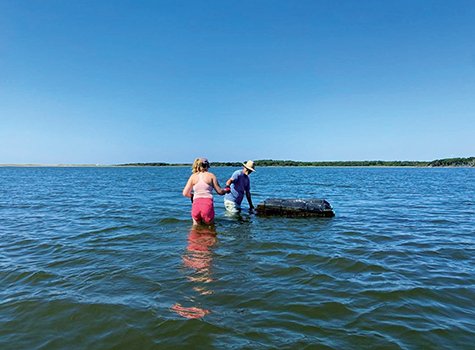ON ISLAND

The MV Shellfish Group
Enhancing shellfish resources for the well-being of the Island Community.
By Amelia Smith
The original Martha’s Vineyard shellfish hatchery looks like a cluster of untidy boxes teetering over Lagoon Pond. Built in 1980, this was the first public solar shellfish hatchery in the United States. “We pioneered hatchery and field cultivation methods for the bay scallop,” wrote Rick Karney, director emeritus. “Today, our successful hatchery and bay scallop culture methods are being copied up and down the east coast.”
Rick was hired in 1976 to provide technical assistance for the management of the Vineyard’s shellfish resources. By the time Rick retired in 2017, the MV Shellfish Group had two more hatcheries and its scope had expanded to incorporate habitat restoration, education, and more.
In 2017, he handed leadership over to co-directors Amandine Surier Hall, who now teaches chemistry at the Martha’s Vineyard Regional High School, and Emma Green-Beach, current Executive Director.
“The Vineyard Haven hatchery is such a beautiful thing partly because it’s so simple,” Emma says. “It gets enough plankton from the Lagoon that they don’t need to grow it – but we can’t always protect ourselves from harmful algae blooms.” Since 2011, the group has leased the John T Hughes Hatchery and Research Facility (a.k.a. the Lobster Hatchery) across the Lagoon in Oak Bluffs, which is named for John Hughes, the first director of the State Lobster Hatchery. “The lobster research that he did here paved the way for crustacean research globally,” Emma says. “There are people across the world who did research and summer jobs here.” This larger space gives the MV Shellfish Group added capacity and flexibility, and it can accommodate more current technology like UV sterilization. There’s also a Chappaquiddick hatchery, an MV Land Bank property located in a former summer house near the Chappy Ferry.
“Our unique place in the industry is that we have a lot of flexibility,” Emma says. Each hatchery location has its own strengths, and despite being on the Vineyard, the MV Shellfish Group has a lower cost of operation than most research labs: it doesn’t have the administrative overhead of a university. “We have a harder time doing focused experiments, because our main mission is to grow shellfish for the Island towns, and everything else is just to support that,” Emma says. Earlier this year, she got a call from the National Marine Fisheries asking them if the MV Shellfish Group could grow surf clams. Fisheries had called three other hatcheries and none of them were able to do it, so Emma took on the challenge. “We had the surf clams at all three facilities because water quality in the Lagoon hasn’t been good, and sometimes that has consequences on the hatchery,” she says. The experiment was a success, and on the day I talked to her Emma was about to send the clams over to Woods Hole on the ferry, with over a hundred thousand tiny surf clams to spare.
Hatched shellfish need a place to grow, and since the 1970s climate change has dramatically increased the need for habitat maintenance and preservation. The MV Shellfish Group cultivates ribbed mussels to assist in that, as well as doing eelgrass restoration and shell reclamation. “Ribbed mussels live in the marsh and have an important symbiotic relationship with marsh grass,” Emma says. “It’s not considered a food species, so it can be planted in places that don’t qualify for shellfish cultivation. The Hughes Hatchery is one of only a handful of hatcheries to have successfully grown ribbed mussels, and they don’t take every year. It’s a new species that acts more like a wild animal. We’re working on developing protocols because there are none in place.”
“Growing shellfish is very simple on a good day, but on a bad day it gets complex,” says Emma. “Climatic trends affect the water in ways that you can’t always see or easily measure – or easily predict. We can’t tell from year to year what’s going to be the new norm, the goal post is always moving and the conditions are always shifting in this really multi-faceted way.” For all of the innovative work it does, the MV Shellfish Group is fundamentally a municipal project, serving the six Island towns’ need for scallops, quahogs, and oysters, and it is primarily funded by the towns. The group has grown to meet the Island’s increasing need for its work, and the demand for seed shellfish is much greater than it was a few decades ago – commercial oyster farmers on the Vineyard often get their seed shellfish from off-Island hatcheries, but this year MVSG even grew a small amount of seed for the private sector as well. The Martha’s Vineyard Shellfish Group works to ensure the health of the Island’s waters, and in doing so its impact extends beyond these shores.
For more info check out their website: mvshellfishgroup.org.
The MV Shellfish Group is funded with public and private funds. Please consider becoming a donor. It's easy and tax deductible. Phone them at : 508.693.0391








